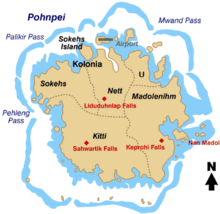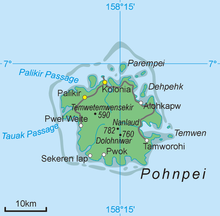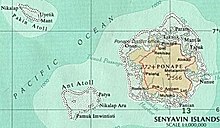Pohnpei: Difference between revisions
→Nearby islands: not the only book |
|||
| Line 32: | Line 32: | ||
Pohnpei was first sighted by Europeans in 1828 by the Russian navigator [[Fyodor Litke]]. From the mid 1800s to early 1900s, [[whaler]]s, missionaries, the Spanish and Germans came to/took over the island. [[Sokeh's Rebellion]] started on October 18, 1910. |
Pohnpei was first sighted by Europeans in 1828 by the Russian navigator [[Fyodor Litke]]. From the mid 1800s to early 1900s, [[whaler]]s, missionaries, the Spanish and Germans came to/took over the island. [[Sokeh's Rebellion]] started on October 18, 1910. |
||
The island was a [[Japan]]ese territory in [[World War II]], Japan having acquired Pohnpei along with the rest of the [[Caroline Islands|Carolines]], the [[Marshall Islands|Marshalls]], and the [[Marianas]] ( |
The island was a [[Japan]]ese territory in [[World War II]], Japan having acquired Pohnpei along with the rest of the [[Caroline Islands|Carolines]], the [[Marshall Islands|Marshalls]], and the [[Marianas]] (except for American-owned [[Guam]]) as [[war reparations]] from [[Germany]]. However, the island was one of those bypassed by the [[US Navy]] during the [[island hopping|island-hopping]] amphibious campaigns of 1943-1945. The military facilities were shelled though on several occasions, including by the [[battleship]]s [[USS Massachusetts (BB-59)|USS ''Massachusetts'' (BB-59)]] and [[USS Iowa (BB-61)|''Iowa'' (BB-61)]], as well as being attacked by the [[aircraft]] of [[USS Cowpens (CVL-25)|''Cowpens'' (CVL-25)]]. In 1945, when the Japanese lost the war, all Japanese citizens were forced off the island. Many of their Pohnpeian families remained. |
||
The Federated States of Micronesia achieved independence in 1986. |
The Federated States of Micronesia achieved independence in 1986. |
||
Revision as of 09:04, 8 October 2010







Pohnpei "upon (pohn) a stone altar (pei)" (formerly known as Ponape) is the name of one of the four states in the Federated States of Micronesia (FSM), situated among the Senyavin Islands which are part of the larger Caroline Islands group. Palikir, the FSM's capital, is located on Pohnpei. Pohnpei International Airport (IATA code PNI) is located near Kolonia, on a small island named Deketik off the northern coast of the main island.
Pohnpei Island is the largest, highest, most populous, and most developed single island in the FSM. The islanders of Pohnpei have a reputation as being the most welcoming of outsiders among residents of the island group. The island also contains a wealth of biodiversity.
Pohnpei is one of the wettest places on earth with annual recorded rainfall exceeding 300 inches (7,600 mm) each year in certain mountainous locations.
Geography
The population of Pohnpei is approximately 34,000. The majority of the population consider themselves ethnic Pohnpeian although Pohnpei is more ethnically diverse than any other island in the FSM. This is largely due to more than a century of foreign occupation, bringing in Japanese, Chamorro, Filipino, American, Australian, German, Spanish, and other Western European people, and it being home to the capital of the national government, which employs hundreds of people from the other three FSM States (Yap, Chuuk, Kosrae) having distinct ethnic and cultural origins. The indigenous makeup also includes the multiple regional ethnicities of the outer islands within Pohnpei State, resulting in a mix of Australasian Pacific Islanders and hence making Pohnpei Island the FSM's melting pot.
At over 780 metres (2,560 ft), Pohnpei's tallest peaks are lush and verdant, towering above a gentle talus slope at lower elevations around its 80-mile (130 km) circumference, surrounded by a coral reef.
Pohnpei's outer islands include Pingelap, Mokil, Ant, Pakin, Ngatik, Nukuoro, and Kapingamarangi.
Biodiversity
Pohnpei is home to several bird species including four endemic species, the Pohnpei Lorikeet, the Pohnpei Fantail, the Pohnpei Flycatcher and the Long-billed White-eye. A fifth endemic, the Pohnpei Starling, is thought to have recently gone extinct.
History
The offshore city of Nan Madol was built here, which was the capital of the Saudeleur dynasty until about AD 1500.
Pohnpei was first sighted by Europeans in 1828 by the Russian navigator Fyodor Litke. From the mid 1800s to early 1900s, whalers, missionaries, the Spanish and Germans came to/took over the island. Sokeh's Rebellion started on October 18, 1910.
The island was a Japanese territory in World War II, Japan having acquired Pohnpei along with the rest of the Carolines, the Marshalls, and the Marianas (except for American-owned Guam) as war reparations from Germany. However, the island was one of those bypassed by the US Navy during the island-hopping amphibious campaigns of 1943-1945. The military facilities were shelled though on several occasions, including by the battleships USS Massachusetts (BB-59) and Iowa (BB-61), as well as being attacked by the aircraft of Cowpens (CVL-25). In 1945, when the Japanese lost the war, all Japanese citizens were forced off the island. Many of their Pohnpeian families remained.
The Federated States of Micronesia achieved independence in 1986.
With its spectacular and relatively unspoiled coral reefs, Pohnpei has long had a following among deep-sea fishermen and SCUBA enthusiasts.
Nearby islands
- The atoll of Pingelap, located 270 kilometres (170 mi) to the east of Pohnpei, but part of Pohnpei State, is notable for the prevalence of the extreme form of color blindness known as maskun. Maskun is relatively rare but often shows up in communities with small gene pools. Pingelap was featured in the book The Island of the Colorblind by neurologist Oliver Sacks.
- The ancient artificial islands of Nan Madol are immediately adjacent to Pohnpei.
- Oroluk Atoll
Administrative divisions
Municipalities of Pohnpei:
- Kapingamarangi (far southwest atoll)
- Kitti (main island, southwest — includes Ant/Ahnd Atoll)
- Kolonia (main island, north)
- Madolenihmw (main island, east)
- Mokil Atoll (near east atoll)
- Nett (main island, north/center, formerly including state capital Kolonia on the north coast)
- Ngatik (near southwest atoll)
- Nukuoro (southwest atoll)
- Oroluk (west atoll, includes Minto Reef)
- Pingelap (far east atoll)
- Sokehs (main island, northwest — includes Pakin Atoll)
- U (main island, northeast)
- Sapwalap (main island, west, just north of Nan Madol)
Sport
Pohnpei is incorrectly said to have a national soccer team described as "the worst team in the world."[1] Pohnpei is, however, not a nation - it is but one of four states in the FSM. A Pohnpei football team is currently active and moves are underway to re-create a national Federated States of Micronesia team.
The FSM is part of the international Olympic movement and sent teams to the last two summer games in Beijing, China and Sydney, Australia with athletes participating in track and field, swimming and weightlifting, but not soccer. The FSM last organized a national football side for the South Pacific Games football tournament in 2003, where it lost all its matches. Prior to that tournament, however, the FSM National team went undefeated winning the Micronesian Cup 1999. The most notable Pohnpeian athlete is marathoner Elias Rodriguez who ran for the FSM at the Sydney Olympics. Mr. Rodriguez finished last in the marathon but was cheered on by tens of thousands of spectators and watched by millions of television viewers as he entered the Olympic stadium for a final lap immediately prior to the closing ceremony which was delayed to allow his finish.
Pohnpei in fiction
Pohnpei plays a central role in the fictional Cthulhu Mythos, in which it is only about a ten days journey by fast ship away from the fictional island of R'lyeh, where Cthulhu resides. Several stories by H. P. Lovecraft, August Derleth and others use this island as a setting or contain references to it.
Pohnpei's role in the Mythos was inspired by the ruins of Nan Madol (see above), which had already been used as the setting for a lost race story by Abraham Merritt, The Moon Pool, in which the islands are called Nan-Matal.[2] Some people believe Nan Madol to be connected to the lost continent of Lemuria.
Pohnpei and the ruins of Nan Madol also play a central role in author James Rollins' book, Deep Fathom.
These are also featured in Clive Cussler's 2009 novel Medusa.
Pohnpei, or "Ponape" as it is spelled, is stated as the home island of "Mike" on the popular blog Dunce Upon A Time, authored by BC Woods.[3]
See also

References
- ^ Bristol Evening Post, 14 August 2009.
- ^ "they had set forth for the Nan-Matal, that extraordinary group of island ruins clustered along the eastern shore of Ponape in the Carolines"
- ^ "The Micronesian Elvis". Dunce Upon A Time. 2007-08-30. Retrieved 2009-08-17.
Further reading
- The Island of the Colour-blind, Oliver Sacks, Publisher: Pan Macmillan (June 6, 1997), paperback, ISBN 0-330-35234-2.
- "Upon a Stone Altar:A History of the Island of Pohnpei to 1890", David Hanlon, Publisher: University of Hawaii Press (May, 1988), paperpack, ISBN 978-0-8248-1124-2
- "Pohnpei, an Island Argosy", Gene Ashby, Publisher: Rainy Day Pr West; Revised edition (June 1987), paperback, ISBN 978-0931742149
- "Nest in the Wind: Adventures in anthropology on a tropical island", Martha C Ward, Publisher: Waveland Press Inc. (1989), paperback, ISBN 0-88133-405-7
External links
- Palikir Marine Adventures
- The Surf Travel Company
- The undisclosed Surfer magazine cover of Dan Malloy riding Palikir Pass, Pohnpei, the Federated States of Micronesia, February 2000
- myMicronesia/Pohnpei section
- Pohnpei-Between Time & Tide
- A Tour of Pohnpei
- FSM Visitors Board/Pohnpei Section
- Jane's Pohnpei Page
- Postcards from Pohnpei: marine life
- Micronesia Conservation Trust
- Pohnpei travel guide at Travellerspoint
